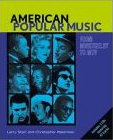 American Popular Music: From Minstrelsy to MTV, by Larry Starr and Christopher Waterman. New York: Oxford University Press, 2003. xii, 500 pages. ISBN 019510854X.
American Popular Music: From Minstrelsy to MTV, by Larry Starr and Christopher Waterman. New York: Oxford University Press, 2003. xii, 500 pages. ISBN 019510854X.
Several studies and textbooks on American music have appeared in recent years, and popular music is one area represented within this broader category. In American Popular Music: From Minstrelsy to MTV, Larry Starr and Christopher Waterman have assembled a comprehensive volume that not only would make an excellent textbook for courses in American popular music but also will be of tremendous interest to the general reader.
The authors lead us chronologically through the metamorphosis of American popular music from minstrelsy to works played on today's leading-edge radio stations. Each chapter is rich with historical and social context. The authors provide vivid, non-technical descriptions of the music itself as well as discussions of its most significant creators and performers. Listening charts appear throughout the text to guide the listener through selected works. Written without musical notation, the charts use lyrics as identifiable markers, thus making them easily accessible to those with limited musical knowledge. The book also has numerous boxed-off sections, placed so as not to disrupt the flow of the text, that give further details about important people or subjects. Specialized musical terms appear in boldface and are included in a glossary at the end of the book. The authors provide an introductory chapter in which they address five basic themes that run throughout the book: 1) Listening; 2) Music and Identity; 3) Music and Technology; 4) The Music Business; and 5) Centers and Peripheries. They also introduce three "Streams of Tradition" for popular music: 1) The European American Stream; 2) The African American Stream; and 3) The Latin American Stream. The authors thus provide a solid thematic and pedagogical framework to which they refer and build upon throughout the volume.
Many history texts tend to focus on specific time periods and a series of people working during those eras. Genres are often compartmentalized within this somewhat rigid structure. Starr and Waterman, however, merge eras and genres, creating a more realistic scenario. In Chapter 8, "'Rock around the Clock': Rock 'n' Roll, 1954-1959," for example, while Elvis Presley and rhythm & blues artists are the focus of the chapter, the authors step back to the Tin Pan Alley age to show the influence that this music had on artists such as Fats Domino and the Platters. This integrated discussion of styles within a single chapter helps students understand the constantly changing nature of music while viewing it within a continuum.
American Popular Music does not back away from controversial issues related to the genre such as race, sexuality, and drugs. This information is important and necessary to the understanding of popular music styles in America, and the authors approach the topics objectively, writing with clarity and consideration for their subjects and audiences.
An important component of this publication is the inclusion of a two-CD set of recordings with forty-three tracks. The recordings do not cover all of the artists discussed in the text, but provide a solid representation of its overall contents. As mentioned by Starr and Waterman, the majority of music not included on the CDs is readily available elsewhere. Excluding some of the early examples in which the sound reproduction was already poor by modern standards, the recordings are of excellent quality.
Starr and Waterman's book is a solid resource for anyone interested in the genesis of American popular music. American Popular Music: From Minstrelsy to MTV is a well-crafted book for use in the classroom or elsewhere. Providing a useful guide to the understanding of popular music in America, the authors masterfully weave the various strands of popular music into a single multi-layered storyline.


